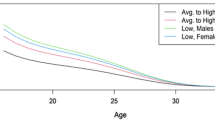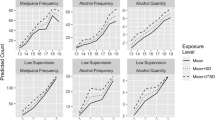Abstract
This study examines differences among older and younger adolescents in the influence of family structure, family relations, and peer relations on marijuana use. Data from a longitudinal sample of adolescents from the United States were stratified by age and used to assess these potential differences. Precise measures of family structure were constructed to account for the various manifestations of family forms. Multivariate analyses indicate that a recent divorce attenuates attachment among younger adolescents and leads to less family involvement among older adolescents. Moreover, older adolescents from stepparent families are less attached to their families. Changes in these family relationship variables influence associations with drug using peers, but these processes differ for the two age groups. Finally, less family involvement and greater drug using peer associations lead to greater marijuana use among younger adolescents, while only peer associations directly affect use among older adolescents.
Similar content being viewed by others
References
Amato, P. R. (1987). Family processes in one-parent, stepparent, and intact families.J. Marriage Family 49: 327–337.
Amato, P. R., and Keith, B. (1991). Parental divorce and the well-being of children: A metaanalysis.Psychol. Bull. 110: 26–46.
Amemiya, T. (1985).Advanced Econometrics. Harvard University Press, Cambridge, MA.
Bailey, S. L., and Hubbard, R. L. (1990). Developmental variation in the context of marijuana initiation among adolescents.J. Health Social Behav. 31: 58–70.
Bailey, S. L., and Hubbard, R. L. (1991). Developmental changes in peer factors and the influence on marijuana initiation among secondary school students.J. Youth Adolesc. 20: 339–360.
Baron, R. M., and Kenny, D. A. (1986). The moderator-mediator distinction in social psychological research: Conceptual, strategic, and statistical considerations.J. Personal. Social Psychol. 51: 1173–1182.
Berk, R. A. (1983). An introduction to selection bias in sociological data.Am. Social. Rev. 48: 386–398.
Berndt, T. J. (1979). Developmental changes in conformity to peers and parents.Develop. Psychol. 15: 608–616.
Block, J. H., Block, J., and Gjerde, P. F. (1986). The personality of children prior to divorce.Child Develop. 57: 827–840.
Brody, G. H., and Forehand, R. (1988). Multiple determinants of parenting: Research findings and implications for the divorce process. In Hertherington, E. M., and Arasteh, J. D. (eds.),Impact of Divorce, Single Parenting, and Stepparenting on Children. Lawrence Erlbaum, Hillsdale, NJ.
Brook, J. S., Brook, D. W., Gordon, A. C., Whiteman, M., and Cohen, P. (1990). The psychosocial etiology of adolescent drug use: A family interactional approach.Genet. Social Gen. Psychol. Monogr. 116: 111–267.
Cherlin, A. J., Furstenberg, F. F., Chase-Lansdale, P. L., Kiernan, K. E., Robins, P. K., Morrison, D. R., and Teitler, J. O. (1991). Longitudinal studies of effects of divorce on children in Great Britain and the United States.Science 252: 1386–1389.
Cohen, A. (1983). Comparing regression coefficients across subsamples: A study of the statistical test.Social. Res. Methods 12: 77–94.
DeFleur, L. B. (1975). Biasing influences on drug arrest records: Implications for deviance research.Am. Social. Rev. 40: 88–103.
Dishion, T. J., and Loeber, R. (1985). Adolescent marijuana and alcohol use: The role of parents and peers revisited.Am. J. Drug Alcohol Abuse 11: 11–25.
Doherty, W. J., and Needle, R. H. (1991). Psychological adjustment and substance use among adolescents before and after a parental divorce.Child Develop. 62: 328–337.
Elliott, D. S., Ageton, S. S., Huizinga, D., Knowles, B., and Canter, R. (1983). The prevalence and incidence of delinquent behavior, 1976–1980. Project Report No. 26, Behavioral Research Institute, Boulder, CO.
Elliott, D. S., Huizinga, D., and Ageton, S. S. (1985).Explaining Delinquency and Drug Use. Sage Publications, Newbury Park, CA.
Farnworth, M. (1984). Family structure, family attributes, and delinquency in a sample of low-income, minority males and females.J. Youth Adolesc. 13: 349–364.
Flewelling, R. L., and Bauman, K. E. (1990). Family structure as a predictor of initial substance use and sexual intercourse in early adolescence.J. Marriage Family 52: 171–181.
Forehand, R., Long, N., and Brody, G. (1988). Divorce and marital conflict: Relationship to adolescent competence and adjustment in early adolescence. In Hetherington, E. M., and Arasteh, J. D. (eds.),Impact of Divorce, Single Parenting, and Stepparenting on Children. Lawrence Erlbaum, Hillsdale, NJ.
Forgatch, M. S., Patterson, G. R., and Skinner, M. L. (1988). A mediational model for the effect of divorce on antisocial behavior in boys. In Hetherington, E. M., and Arasteh, J. D. (eds.),Impact of Divorce, Single Parenting, and Stepparenting on Children. Lawrence Erlbaum, Hillsdale, NJ.
Furstenberg, F. F., and Cherlin, A. J. (1991).Divided Families: What Happens to Children When Parents Part. Harvard University Press, Cambridge, MA.
Ginsberg, I. J., and Greenley, J. R. (1978). Competing theories of marijuana use: A longitudinal study.J. Health Social Behav. 19: 22–34.
Glenn, N. D., and Shelton, B. A. (1983). Preadult background variables and divorce: A note of caution about overreliance on explained variance.J. Marriage Family 45: 405–410.
Hetherington, E. M. (1987). Family relations six years after divorce. In Pasley, K., and Ihinger-Tallman, M. (eds.),Remarriage and Stepparenting Today: Current Research and Theory. Guilford Press, New York.
Hetherington, E. M., Cox, M., and Cox, R. (1982). Effects of divorce on parents and children. In Lamb, M. (ed.),Nontraditional Families: Parenting and Child Development. Lawrence Erlbaum, Hillsdale, NJ.
Hetherington, E. M., Stanley-Hagan, M., and Anderson, E. R. (1989). Marital transitions: A child's perspective.Am. Psychol. 44: 303–312.
Hirschi, T. (1969).Causes of Delinquency. University of California Press, Berkeley, CA.
Huba, G. J., and Bentler, P. M. (1980). The role of peer and adult models for drug taking at different stages in adolescence.J. Youth Adolesc. 9: 449–465.
Hundlesby, J., and Mercer, G. W. (1987). Family and friends as social environments and their relationship to young adolescents' use of alcohol, tobacco, and marijuana.J. Marriage Family 49: 151–164.
Ihinger-Tallman, M. (1988). Research on stepfamilies.Ann. Rev. Social. 14: 25–48.
Jensen, G., and Brownfield, D. (1982). Parents and drugs: specifying the consequences of attachment.Criminology 21: 543–554.
Johnson, R. E. (1986). Family structure and delinquency: General patterns and gender differences.Criminology 24: 65–84.
Johnson, R. E., Marcos, A. C., and Bahr, S. J. (1987). The role of peers in the complex etiology of adolescent drug use.Criminology 25: 323–339.
Kandel, D. B. (1978). Homophily, selection, and socialization in adolescent friendship.Am. J. Social. 84: 427–436.
Kandel, D. B. (1980). Drug and drinking behavior among youth.Ann. Rev. Social. 6: 235–285.
Kandel, D. B., Kessler, R. C., and Margulies, R. Z. (1978). Antecedents of Adolescent Initiation into Stages of Drug Use: A Developmental Analysis.Youth and Adolesc. 7: 13–40.
Kellam, S. G., Adams, R., Brown, C. H., and Ensminger, M. E. (1982). The Long-Term Evolution of the Family Structure on Teenage and Older Mothers.Marriage Family 44: 539–554.
LaGrange, R. L., and White, H. R. (1985). Age differences in delinquency: A test of theory.Criminology 23: 19–45.
Lehman, D. R., Lang, E. L., Wortman, C. B., and Sorenson, S. B. (1989). Long term effects of sudden bereavement: Marital and parent-child relationships and children's reactions.J. Family Psychol. 2: 344–367.
Liska, A. E., and Reed, M. D. (1985). Ties to conventional institutions and delinquency: Estimating reciprocal causal effects.Am. Social. Rev. 50: 547–560.
Little, R. (1985). A note about models for selectivity bias.Econometrica 53: 1469–1474.
Loeber, R., and Stouthamer-Loeber, M. (1986). Family factors as correlates and predictors of juvenile conduct problems and delinquency. In Tonry, M., and Morris, N. (eds.),Crime and Justice: An Annual Review of Research (Vol. 7). University of Chicago Press, Chicago.
Maddala, G. S. (1983).Limited-Dependent and Qualitative Variables in Econometrics. Cambridge University Press, Cambridge.
Matsueda, R. L., and Heimer, K. (1987). Race, family structure, and delinquency: A test of differential association and social control theories.Am. Social. Rev. 52: 826–840.
Mednick, B. R., Baker, R. L., and Carothers, L. E. (1990). Patterns of family instability and crime: The association of timing of the family's disruption with subsequent adolescent and young adult criminality.J. Youth Adolesc. 19: 201–220.
Menard, S. (1991).Longitudinal Research. Sage University Paper Series on Quantitative Applications in the Social Sciences, 07-076. Sage Publications, Newbury, Park, CA.
Needle, R. H., Su, S. S., and Doherty, W. (1990). Divorce, remarriage, and adolescent substance use: A prospective longitudinal study.J. Marriage Family 52: 157–169.
Nelson, G. (1982). Coping with the loss of father: Family reaction to death or divorce.J. Family Issues 3: 41–60.
Peterson, J. L., and Zill, N. (1986). Marital disruption, parent-child relationships, and problem behavior in children.J. Marriage Family 48: 295–307.
Plewis, I. (1985).Analyzing Change: Measurement and Explanation Using Longitudinal Data. John Wiley & Sons, New York.
Selnow, G. (1987). Parent-child relationships and single and two parent families: Implications for substance usage.J. Drug Educat. 17: 315–326.
Simons, R. L., and Robertson, J. F. (1989). The impact of parenting factors, deviant peers, and coping style upon adolescent drug use.Family Relat. 38: 273–281.
Smith, D. A., and Paternoster, R. (1987). The gender gap in theories of deviance: Issues and evidence.J. Res. Crime Delinq. 24: 140–172.
Thornberry, T. P. (1987). Toward an interactional theory of delinquency.Criminology 25: 863–891.
Thornberry, T. P., Lizotte, A. J., Krohn, M. D., Farnworth, M., and Jang, S. J. (1991). Testing interactional theory: An examination of reciprocal causal relationships among family, school, and delinquency.J. Crim. Law Criminol. 82: 3–35.
Tobin, J. (1958). Estimation of relationships for limited dependent variables.Econometrica 26: 24–36.
Van Voorhis, P., Cullen, F., Mathers, R., and Garner, C. C. (1988). The impact of family structure and quality on delinquency: A comparative assessment of structural and functional factors.Criminology 26: 235–261.
Wallace, J. M., and Bachman, J. G. (1991). Explaining racial/ethnic differences in adolescent drug use: The impact of background and lifestyle.Social Problems 38: 333–357.
Wallerstein, J. S., and Kelly, J. B. (1980).Surviving the Breakup: How Children and Parents Cope With Divorce. Basic Books, New York.
Wells, L. E., and Rankin, J. H. (1991). Families and delinquency: A meta-analysis of the impact of broken homes.Social Problems 38: 71–93.
White, H. R., Pandina, R., and LaGrange, R. L. (1987). Longitudinal predictors of serious substance use and delinquency.Criminology 25: 715–740.
Zill, N. (1988). Behavior, achievement, and health problems among children in stepfamilies: Findings from a national survey of child health. In Hetherington, E. M., and Arasteh, J. D. (eds.),Impact of Divorce, Single Parenting, and Stepparenting on Children. Lawrence Erlbaum, Hillsdale, NJ.
Author information
Authors and Affiliations
Additional information
This research was partially funded by a Faculty Research Grant provided by the University of North Carolina—Charlotte. The data used in this paper were made available by the Inter-university Consortium for Political and Social Research. The data for the National Youth Survey, 1976 to 1978 (Waves 1–3), were originally collected by Delbert Elliott and colleagues at the Institute of Behavioral Science. Neither the collectors of the original data nor the consortium bear any responsibility for the analyses or interpretations presented here.
Received Ph.D. from the State University of New York at Albany. Current research interests include adolescent drug use, social-psychological determinants of violence, and behavioral aspects of HIV transmission.
Rights and permissions
About this article
Cite this article
Hoffmann, J.P. Investigating the age effects of family structure on adolescent Marijuana use. J Youth Adolescence 23, 215–235 (1994). https://doi.org/10.1007/BF01537446
Received:
Accepted:
Issue Date:
DOI: https://doi.org/10.1007/BF01537446




